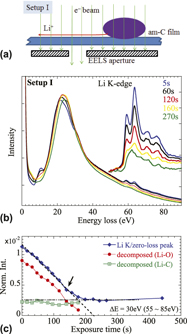Crossref Citations
This article has been cited by the following publications. This list is generated based on data provided by
Crossref.
Jiang, Nan
2016.
Beam damage by the induced electric field in transmission electron microscopy.
Micron,
Vol. 83,
Issue. ,
p.
79.
Jiang, Nan
2016.
Electron beam damage in oxides: a review.
Reports on Progress in Physics,
Vol. 79,
Issue. 1,
p.
016501.
Jiang, Nan
2017.
Note on in situ (scanning) transmission electron microscopy study of liquid samples.
Ultramicroscopy,
Vol. 179,
Issue. ,
p.
81.
Jiang, N.
2019.
The mechanism of nanoparticle precipitation induced by electron irradiation in transmission electron microscopy.
Ultramicroscopy,
Vol. 196,
Issue. ,
p.
18.
Ji, Xujing
Wu, Chunyang
Deng, Jingfei
Li, Jixue
and
Jin, Chuanhong
2020.
Reversible H-T′ phase transition in monolayer molybdenum disulfide via electron beam assisted solid state lithiation/delithiation.
Applied Physics Letters,
Vol. 116,
Issue. 3,
Liang, Chao
Zhang, Xun
Xia, Shuixin
Wang, Zeyu
Wu, Jiayi
Yuan, Biao
Luo, Xin
Liu, Weiyan
Liu, Wei
and
Yu, Yi
2020.
Unravelling the room-temperature atomic structure and growth kinetics of lithium metal.
Nature Communications,
Vol. 11,
Issue. 1,
Ding, Ziming
Tang, Yushu
Chakravadhanula, Venkata Sai Kiran
Ma, Qianli
Tietz, Frank
Dai, Yuting
Scherer, Torsten
and
Kübel, Christian
2023.
Exploring the influence of focused ion beam processing and scanning electron microscopy imaging on solid-state electrolytes.
Microscopy,
Vol. 72,
Issue. 4,
p.
326.
Gonzalez-Martinez, Ignacio
Weinel, Kristina
Feng, Wen
Agudo-Jácome, Leonardo
Gemming, Thomas
and
Büchner, Bernd
2023.
Hybrid tungsten–carbon 2D nanostructures via in situ gasification of carbon substrates driven by ebeam irradiation of WO2.9 microparticles.
Nanotechnology,
Vol. 34,
Issue. 49,
p.
495602.
Weber, Jonathan T.
and
Schäfer, Sascha
2024.
Electron Imaging of Nanoscale Charge Distributions Induced by Femtosecond Light Pulses.
Nano Letters,
Vol. 24,
Issue. 19,
p.
5746.
Feng, Wen
Gemming, Thomas
Giebeler, Lars
Qu, Jiang
Weinel, Kristina
Jácome, Leonardo Agudo
Büchner, Bernd
and
Gonzalez-Martinez, Ignacio
2024.
Influence of magnetic field on electron beam-induced Coulomb explosion of gold microparticles in transmission electron microscopy.
Ultramicroscopy,
Vol. 262,
Issue. ,
p.
113978.
